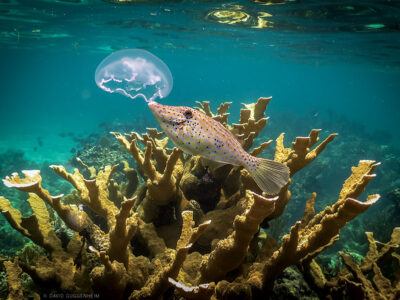
“I never finished anything.” Thus did Harold Sellers Colton C1904 Gr1908 describe the first 20 years of his life, including the front end of his undergraduate career at Penn. For a man who would go on to publish some 260 scientific papers, monographs, and books—becoming a charter member of the Ecological Society of America along the way—that verdict would hardly do as an epitaph. Yet there’s something apt about it. The man started even more projects than his busy 89 years allowed him to complete. And this past March, several of his successors in Penn’s biology department brought one of Colton’s earliest endeavors to a new and unexpected conclusion, nearly a century after it began in 1915.
The current chapter started serendipitously. Jonathan Fisher Gr’07 had been investigating a marine worm that bores into the shells of dog whelks, a sea snail commonly found in the Atlantic. “When I noticed there were old samples at the Academy of Natural Science” in Philadelphia, Fisher recalls, “I took a look at those.”
There were 12,000 of them, deposited there for safekeeping by Colton, who had gathered them from several dozen sites in Maine between 1915 and 1922, during his time as a zoology instructor at Penn. Fisher started out looking at telltale holes in these shells, but soon noticed something unusual about Colton’s cache. The samples looked a lot longer than the present-day specimens Fisher was used to. This was doubly strange, because recent experiments had shown that when dog whelks are exposed to green crabs, an invasive predator that has since moved into the territory Colton studied, their shells actually become shorter (and a bit thicker) in response.
Taking advantage of Colton’s meticulous records, Fisher and Penn biology professor Peter Petraitis decided to resample 19 of his original locations near Mount Desert Island, Maine. Sure enough, the descendents of Colton’s original dog whelks were substantially longer at each site, by an average of 22 percent.
This was something of a shock. “It’s a very, very well-known species,” Petraitis says. “It’s been studied for hundreds of years. And so for no one else to have noticed how different the snails are in size is sort of astounding.”
It’s not clear what accounts for the change, but Fisher and Petraitis have a few theories. Perhaps the presence of green crabs has a different effect on dog whelks over the long run—that after initially responding with shortened, thickened shells that afforded some extra protection, the snails gradually evolved to a length that put them beyond the crabs’ hunting ability.
Alternatively, the disappearance of other predators may come into it. “There’s a lot of things that have been fished out in the last 100 years,” Petraitis points out. “Lobsters used to be intertidal. There are a lot of other fish predators that used to be common that aren’t so common. So maybe the average annual mortality rate is lower—in other words, these animals just live longer because there are fewer predators around, because humans have taken out the predators of these snails.”
Other factors that may be playing a role include rising water temperatures, and increased levels of local nutrient pollution that may be enriching the snails’ diet. Whatever the case, the discovery, which was published in Proceedings of the National Academy of Science in March, shows just how quickly a species can change in a relatively short span.
“The other thing that’s really neat,” Petraitis adds, “is that Colton was both an undergraduate and a professor at the University of Pennsylvania, so it’s kind of cool that you’re actually doing something based on somebody who was here.”
And challenging. Colton published papers on the relationship between dog whelks’ physical characteristics and their habitat in 1916 and 1922. For Fisher, it was important not to retread that research. “I didn’t want to do the same things that were done 80 years before.”
That’s not exactly a typical fear in modern-day marine ecology, but Colton, despite having been almost completely forgotten, was in some ways ahead of his time. “He produced one of the first, if not the first intertidal food web ever published,” Fisher says.
In other ways, he was the very portrait of that species of gentleman scientist that is now all but extinct. As portrayed in a richly detailed biography that has seldom been checked out of the University Museum library, The Life of Harold Sellers Colton: A Philadelphia Brahmin in Flagstaff, Colton’s early career as a zoologist would green a modern-day biology postdoc with envy. In 1907, for example, his accommodation during the Seventh Zoological Conference in Boston was a 53-foot schooner he had commissioned as a 25-year-old graduate student. It was named Clione, after a pteropod mollusk.
Yet marine zoology would only hold his interest for so long. In 1926 Colton left Penn for Flagstaff, Arizona. “He went from being an intertidal biologist to being a desert archaeologist!” Fisher marvels. Colton became an expert in Indian pottery. Along with his wife, an artist, he helped to found the Museum of Northern Arizona, a research center dedicated to preserving the Native American cultures of the region.
All the while, he pursued an astonishingly wide-ranging portfolio of independent scientific research. He studied phytoplankton on Arizona ponds. He wrote about Hopi ethnobotany. When he was 80 years old, he published a study of prehistoric Aboriginal Indian dogs. At 85, he embarked on an investigation of the magnetic polarity of lava flows.
That last project was another that he did not live to finish. Colton died in 1970. Before Jonathan Fisher and Peter Petraitis rediscovered and expanded upon his dog whelk research, his last appearance in these pages was in the Gazette’s April 1971 issue, which featured the following obituary. By the standard of that day as well as this one, it left much unsaid:
“Dr. Harold S. Colton ’04 C, ’08 Gr, Flagstaff, Ariz., December 29.”
—T.P.




